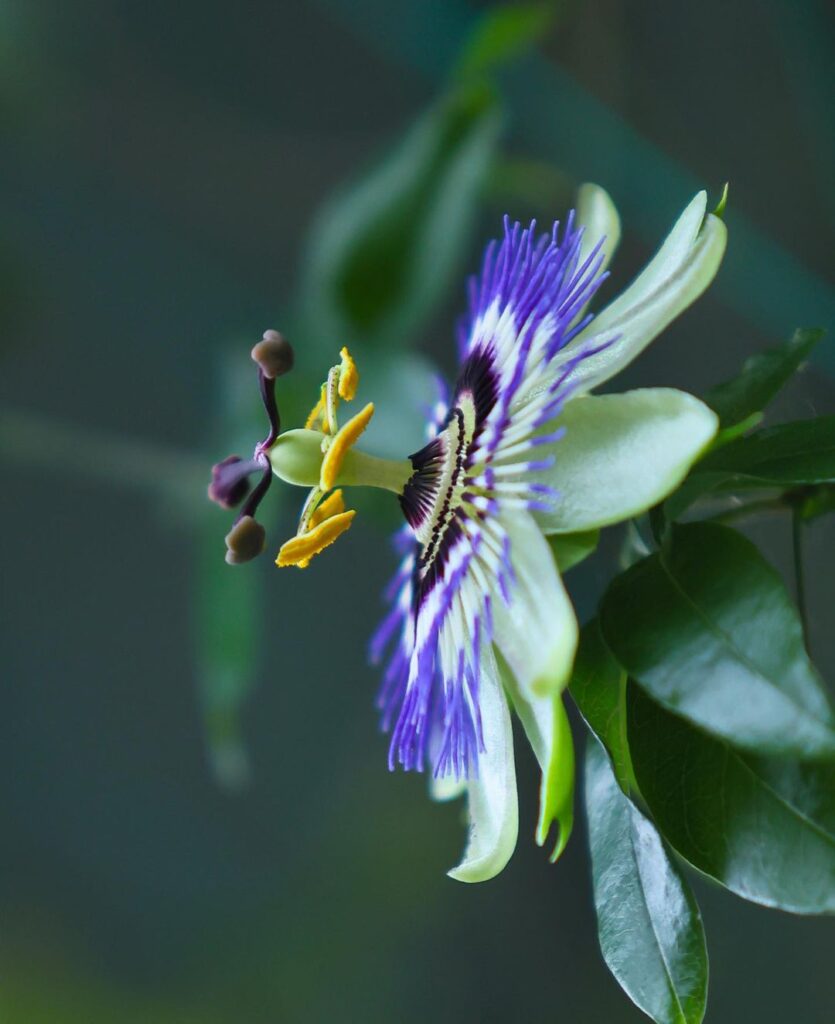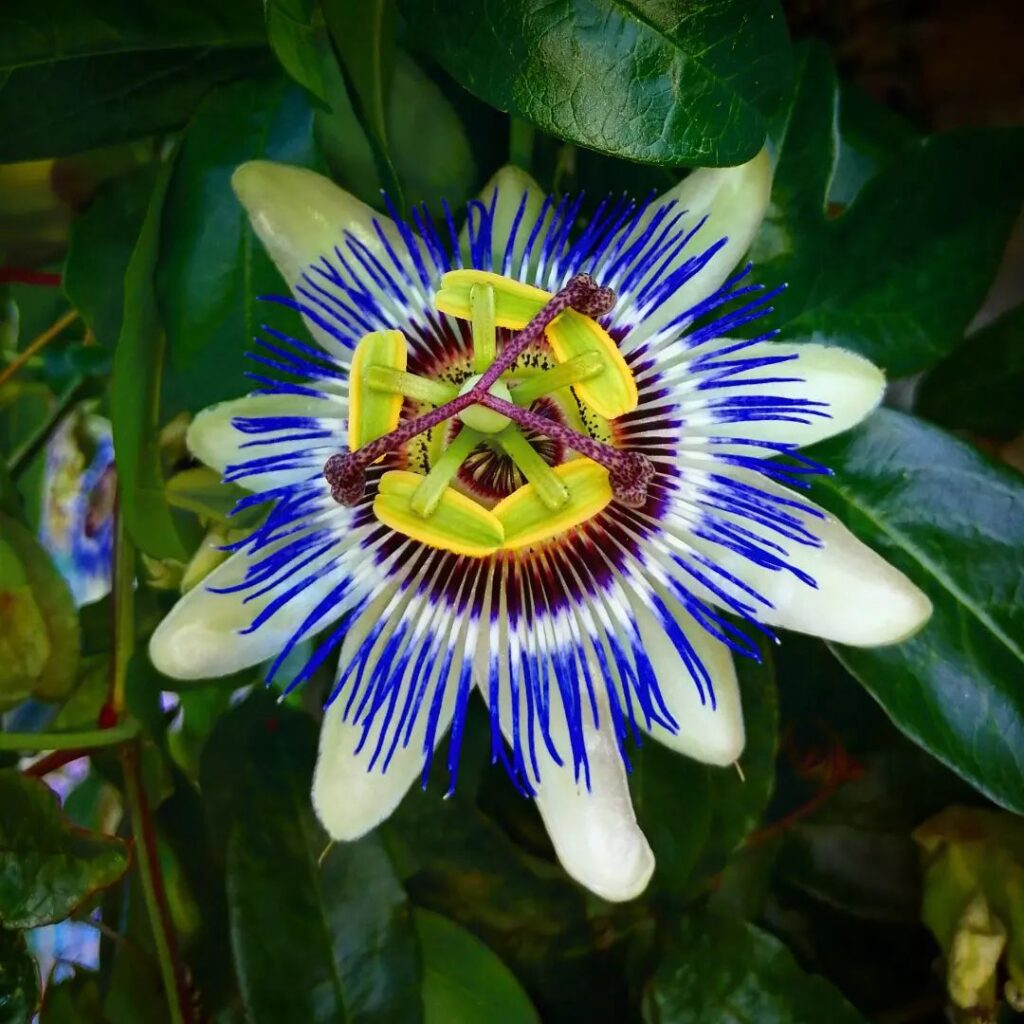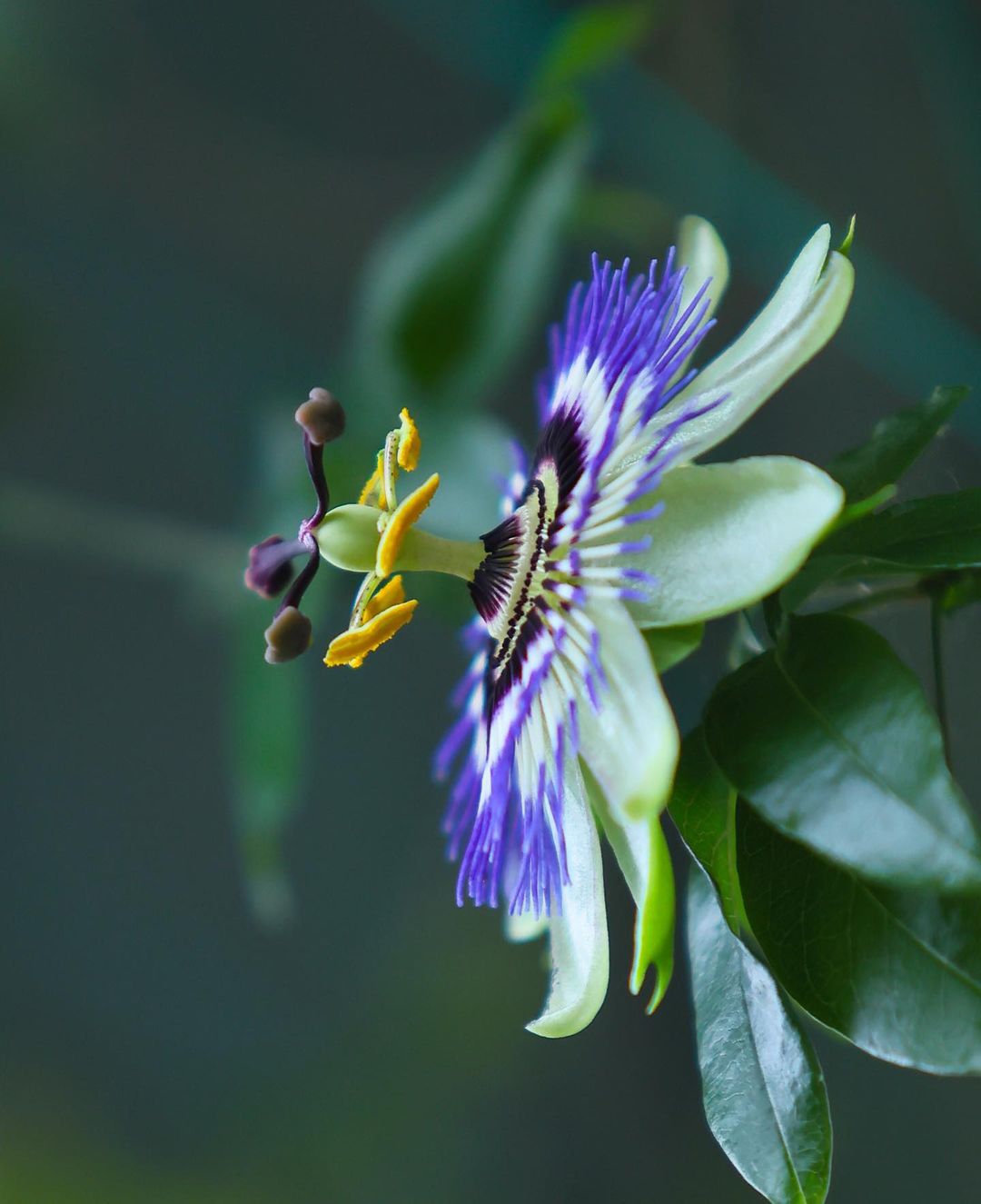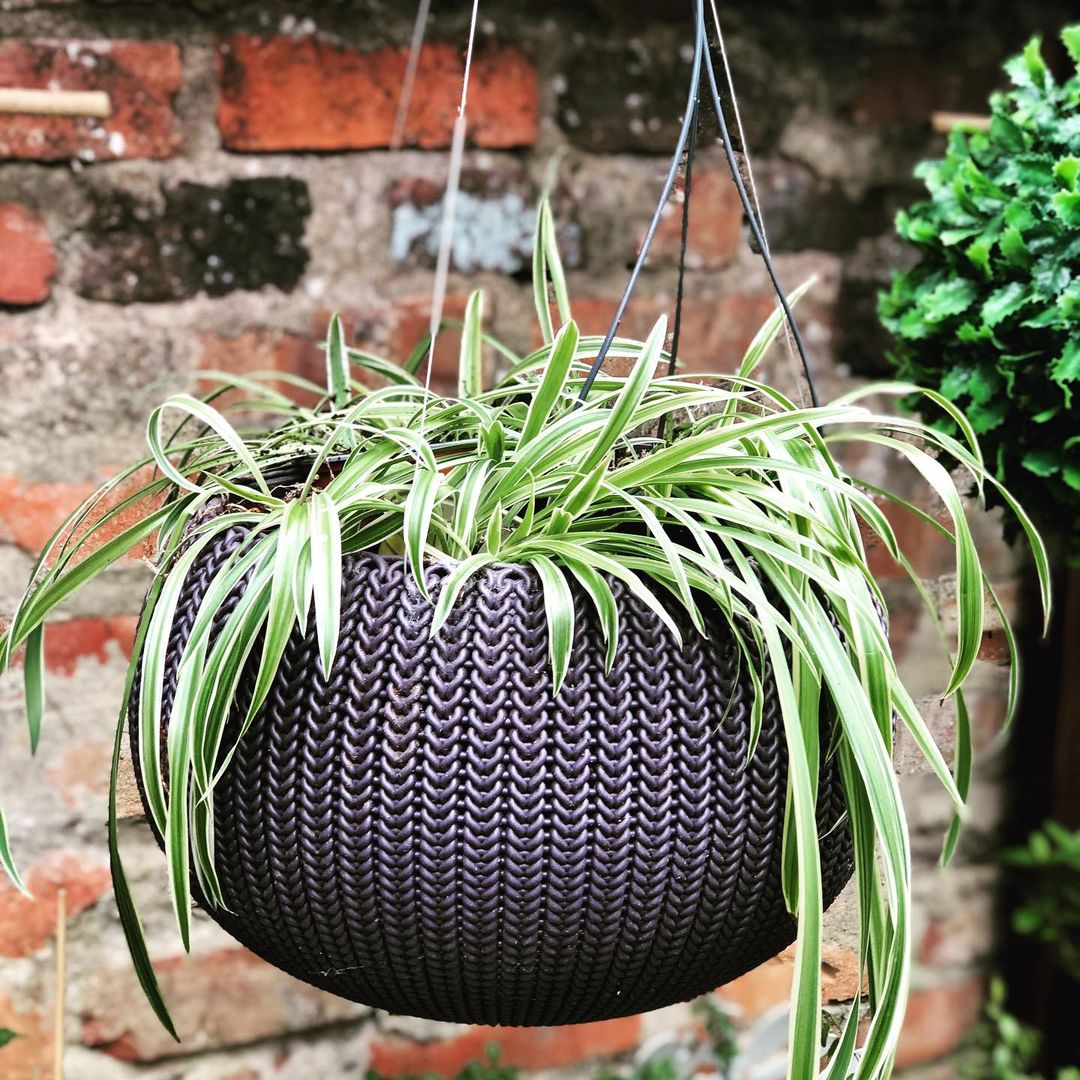Passiflora caerulea is a beautiful climbing vine with leaves that provide a lush background to the striking flowers.
Blue Passionflower is a lovely vining plant with striking flowers that can add beauty to any garden or indoor area. Discover its essential care requirements in this Passiflora Caerulea Growing Guide to ensure its well-being and growth.
Botanical Name: Passiflora Caerulea
Common Names: Blue Passion Flower, Common Passion Flower, Blue Crown, Wild Apricot, Flower of Five Wounds, Southern Beauty, Jesus Flower, Passiflora caerulea flower
USDA Zones: 8-11
Read: Tievine Care and Growing Information
Passiflora Caerulea Profile

Commonly known as the Blue Passionflower, it is native to South America, particularly in Brazil, Argentina, and Paraguay. Passiflora Caerulea belongs to the Passifloraceae family. This vigorous, climbing vine can grow both indoors and outdoors. It has long, thin stems that can reach up to 20 feet long. When grown indoors, the Blue Passionflower can reach a height of around 3 to 6 feet. It will need some support or a trellis to climb on. Outdoors in suitable conditions, Passiflora caerulea can reach heights of up to 20 feet or more. It tends to grow taller when provided with proper support.
They are typically blue and white, about 3 to 4 inches in diameter. The petals are arranged in a distinctive pattern and have a complex structure. The flowers have a pleasant fragrance and are famous for their unique appearance. The leaves of Passiflora caerulea are green and lobed, with serrated edges. They can be around 3 to 6 inches long.
Passiflora caerulea fruit
Commonly known as passionfruit or passionflower fruit, it typically falls within the small to medium size range, measuring around 2 to 3 inches (5 to 7.5 cm) in diameter. It usually has a round to slightly oval shape. The external skin of the Passiflora caerulea fruit displays a color palette that shifts as the fruit matures. Starting out as green, the outer skin transforms into hues of orange or yellow as it reaches full ripeness, adding to its visual appeal.
Inside the Passiflora caerulea fruit, a hollow space contains a bounty of juicy, gel-like pulp. The pulp exhibits a range of colors, spanning from delicate pale yellow to deep shades of orange. Within this pulp, numerous small, edible seeds are snuggled.
The raw flavor profile of passiflora caerulea taste is a distinctive blend of sweetness and tanginess. The juiciness of pulp brings forth a pleasantly tangy note, the intensity of which can vary based on how ripe the fruit is.
When you cook or use Passiflora caerulea’s passionfruit in your recipes, something interesting happens to its flavor. It becomes stronger and more intricate. The cooking process makes the tangy taste milder, so the sweet and fruity flavors stand out even more. This gives your taste buds a more detailed and noticeable experience.
Best Passiflora Caerulea Varieties
- ‘Constance Elliott’: This variety is known for its white flowers with a pale blue tinge at the petals’ base.
- Passiflora caerulea ‘Victoria’: ‘Victoria’ is prized for its large, vibrant blue and white flowers with a distinct blue corona in the center.
- ‘Blue Eyed Susan‘: This variety features flowers with blue and white petals and a unique dark blue center, resembling an “eye.”
- Passiflora caerulea ‘Nova‘: ‘Nova’ is known for its exceptionally large and fragrant flowers. The flowers can reach up to 6 inches (15 cm) in diameter and emit a pleasant fragrance.
- ‘White Lightning‘: As the name suggests, ‘White Lightning’ is distinct for its white flowers. The blooms have a white corona with contrasting blue filaments and anthers.
Note: Blue Passionflower is a species popular for its pretty blue and white flowers. But there are also different varieties of this plant that look a bit different and grow in their own way.
When to Plant Passiflora Caerulea?
Passiflora caerulea should be planted outdoors from mid-spring to fall, depending on the climate in your region. This plant blooms from early summer to early fall, with fruit appearing from early to mid-fall. If you prefer to grow it indoors, you can do so all year round. It’s important to note that it thrives best in climates within USDA hardiness zones six through nine.
Propagating Passiflora Caerulea
1. Propagation by Seeds
To grow blue passion flowers from seeds, collect ripe seeds from the Passiflora caerulea fruit and plant them in seed trays or pots filled with well-draining soil. Keep the soil moist but not waterlogged, and place the trays or pots in a warm location with plenty of light. The seeds usually germinate within two to four weeks.
2. Propagation by Cuttings
- Take a healthy stem cutting from the passiflora caerulea and remove the lower foliage.
- Dip the cut end in rooting hormone and plant it in a container with moist soil.
- Keep the pot in bright, indirect light, and maintain the soil moisture.
- After a few weeks, the cutting should have developed roots and can be transplanted
3. Propagation by Layering
To propagate Passiflora caerulea by layering, select a healthy stem and bend it down towards the soil. Use a small stick to hold the stem in place and cover it with soil. Once roots have developed, usually, within a few weeks, cut the stem from the parent plant and transplant the new plant.
Passiflora Caerulea Care Indoors in Pots?
Blue Passionflower can flourish indoors in pots year-round. Exposing it to at least 4-5 hours of full sunlight daily is essential. Adequate support and pruning are crucial, along with well-draining and moist soil, to foster the healthy growth of the plant.
Ideal Growing Conditions for Passiflora Caerulea

Sunlight
Passiflora Caerulea needs at least 4 to 5 hours of direct sunlight exposure each day to grow optimally and maintain good health.
Planting it in a shaded location will result in fewer flowers and no fruits. Providing shade during the hottest part of the day can benefit areas with extreme climates.
Soil
It requires slightly acidic soil with a pH range of 5.5 to 6.5 to promote healthy growth. Additionally, it is essential to incorporate an abundance of organic matter, such as compost, into the growing medium, which will aid in moisture retention and enhance drainage.
Water
Passiflora Caerulea has a robust root system that can handle dry or challenging climates. Watering this plant infrequently, once every two weeks, encourages its roots to search for moisture deep within the soil. However, watering the plant more frequently may be necessary in hotter climates.
Temperature
Passiflora caerulea prefers a climate that’s neither too hot nor too cold. They like temperatures between 65°F and 85°F (18°C to 29°C) while they’re growing. These flowers can handle short periods of cooler weather, down to about 32°F (0°C), but if it gets too frosty for too long, they might get hurt or die.
In cold or freezing conditions, when you’re growing them in pots, you can bring them inside or put them somewhere sheltered when you know frost is coming. If they’re in the ground, covering them with special cloth or burlap can help keep them warmer and protect them from freezing temperatures.
Read: Thunbergia Erecta Clockvine Care
Passiflora Caerulea Care
Fertilizer
Feed the plant with a slow-release or organic fertilizer such as fish emulsion or compost tea applied every 5-7 weeks according to package instructions. A balanced liquid feed diluted to half strength can also be used, but over-fertilizing should be avoided to prevent damage or plant death.
Support
This vine requires a trellis or arbor for support to climb, and it can be trained to grow upright and orderly by securing it with twine or wire. It also helps and directs Passiflora caerulea flower vines to grow upwards properly.
Pruning
This fast-growing vine can easily reach over 15 feet per year. To ensure the plant remains manageable and healthy, it’s recommended to prune the plant annually. The best time to do this is in late winter or early spring before new growth begins. Along with pruning, removing any spent blooms by deadheading or pinching them away is essential.
Pests and Diseases
Passionflowers are prone to infestations by spider mites and whiteflies. The use of neem oil is an effective way to control these pests.
It grows well in environments with high humidity. However, if the air is stagnant, it may result in the development of fungal diseases. Keep in mind that excessive moisture can cause fungal leaf spots. Therefore, it is essential to promptly remove any affected leaves and treat the plant with a fungicide.
Overwintering
It is important to protect its roots. Applying a layer of mulch around the roots will safeguard them from frost until the arrival of early spring.
Harvesting and Storing Passionflower Fruit
Passiflora Caerulea fruit has a deliciously sweet, concentrated flavor and is a popular ingredient for making jams, jellies, and preserves.
To determine ripeness, check for deep blue-purple color and wrinkling of the fruit. When harvesting, take precautions and wear gloves to avoid the sharp thorns of the plant.
Cut the fruit off the vine, remove any stems or leaves, and place it in a container.
For storage, keep the fruit in a cool and dry place where it can last for several weeks.
Passiflora Caerulea Medicinal Uses
Blue Passionflower has a rich history of medicinal use, particularly for its ability to promote relaxation and alleviate anxiety.
This plant has been traditionally used to treat various conditions, including insomnia, epilepsy, and hysteria.
In addition to its sedative properties, it has also been valued in traditional medicine for its anti-inflammatory, antispasmodic, and analgesic effects.



